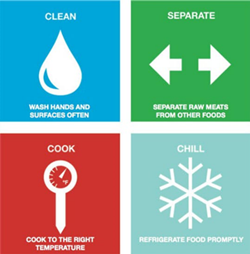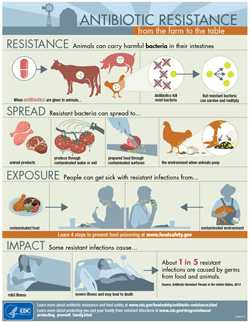Antibiotic Resistance, Food, and Food-Producing Animals

More than 400,000 Americans get sick every year from infections caused by antibiotic-resistant foodborne bacteria, according to CDC estimates. People who are infected with antibiotic-resistant bacteria may experience more severe illness, including hospitalization and death, because these infections can be harder to treat. Learn what CDC is doing and how you can protect yourself and your loved ones from these types of infections.
Antibiotic Resistance and Food Production
Antibiotic resistance is the ability of bacteria to resist the effects of an antibiotic. This means that bacteria are not killed by the antibiotic and can continue to grow. About one in five resistant infections are caused by germs, such as Salmonella and Campylobacter, from food and animals.
Improving antibiotic use can help slow antibiotic resistance.
Antibiotics are medicines that kill bacteria. They are extremely important in treating serious bacterial infections in people. However, bacteria can become resistant to antibiotics when these drugs are given unnecessarily to people or animals who don’t require them. Improving antibiotic prescribing and use is critical to ensure that bacteria don’t become resistant to antibiotics. Prescribers should only treat people and animals with antibiotics when they need them for medically sound reasons.
All humans and animals have bacteria in their gut. When they are given antibiotics, many of these bacteria are killed, but the resistant ones may survive and multiply. This is why the responsible use of antibiotics is so important in both humans and animals.
When animals are slaughtered and processed for food, the bacteria from the animal can contaminate meat or other products. Bacteria also can spread from animal feces (poop) to the environment, which can then contaminate soil and water used to grow fruits and vegetables. Food and the environment can get contaminated with bacteria in these ways, including with bacteria that are resistant to antibiotics.
People can get resistant infections by handling or eating raw or undercooked meat or produce contaminated with resistant bacteria. They can also get sick from contact with animal poop, either through contact with animals and animal environments, or through contaminated drinking or swimming water.
CDC Investigations
Recently, CDC was part of a multistate outbreak investigation of Salmonella Heidelberg infections linked to direct contact with sick calves. Samples of bacteria tested from both sick people and calves were found to be resistant to multiple antibiotics.
Previously, CDC investigated outbreaks of antibiotic-resistant Salmonella infections linked to chicken and pork. Both resulted in product recalls.

What CDC is doing
CDC is working to prevent infections caused by antibiotic-resistant bacteria by:
- Tracking resistant infections and studying how resistance emerges and spreads.
- Detecting and investigating antibiotic-resistant outbreaks quickly to solve, stop, and prevent them.
- Determining the sources of antibiotic-resistant infections that are commonly spread through food and animals.
- Strengthening the ability of state and local health departments to detect, respond to, and report antibiotic-resistant infections.
- Educating consumers and food workers on prevention methods, including safe food handling, safe contact with animals, and proper handwashing.
- Promoting the responsible use of antibiotics in humans and animals.
Protect yourself and your family
There are steps you can take to help protect yourself and your family from antibiotic-resistant foodborne illnesses.
- Take antibiotics only when needed.
-
Follow simple Food Safety Tips:
- COOK. Use a food thermometer to ensure that foods are cooked to a safe internal temperature: 145°F for whole beef, pork, lamb, and veal (allowing the meat to rest for 3 minutes before carving or consuming), 160°F for ground meats, and 165°F for all poultry, including ground chicken and ground.
- CLEAN. Wash your hands after touching raw meat, poultry, and seafood. Also wash your work surfaces, cutting boards, utensils, and grill before and after cooking.
- CHILL. Keep your refrigerator below 40°F and refrigerate foods within 2 hours of cooking (1 hour during the summer heat).
- SEPARATE. Germs from raw meat, poultry, seafood, and eggs can spread to produce and ready-to-eat foods unless you keep them separate. Use different cutting boards to prepare raw meats and any food that will be eaten without cooking.
- Wash your hands after contact with poop, animals, or animal environments.
- Report suspected outbreaks of illness from food to your local health department.
- Review CDC’s Traveler’s Health recommendations when preparing to travel to a foreign country.
For more information on antibiotic resistance and food safety, visit the CDC’s Food Safety page.
- Page last reviewed: July 24, 2017
- Page last updated: July 24, 2017
- Content source:
- National Center for Emerging and Zoonotic Infectious Diseases, Division of Foodborne, Waterborne, and Environmental Diseases
- Page maintained by: Office of the Associate Director for Communication, Digital Media Branch, Division of Public Affairs




 ShareCompartir
ShareCompartir
